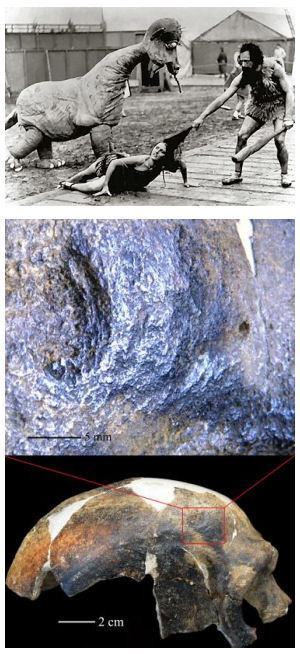22 November 2011
Bashed-in prehistoric skull hints at the invention of violence
by Will Parker
 A 126,000 year-old human cranium (pictured right) exhibiting signs of localized blunt force trauma could represent the earliest known incident of interhuman aggression, says an anthropologist at the University of the Witwatersrand.
A 126,000 year-old human cranium (pictured right) exhibiting signs of localized blunt force trauma could represent the earliest known incident of interhuman aggression, says an anthropologist at the University of the Witwatersrand.
The report, appearing in the Proceedings of the National Academy of Sciences, suggests that a 14mm (0.6 inch) ridged, healed lesion with the bone depressed inward to the brain resulted from trauma due to an accident or, more probably, interhuman aggression. The injury occurred in the right temple region of the skull but it is not known whether the fragment came from a male or female.
The skull fragment, known as the Maba cranium, was discovered in 1958 with the remains of other mammals in a cave at Lion Rock in Guangdong province, China. The Maba cranium and associated animal bones were unearthed at a depth of 1 meter by farmers removing cave sediments for fertilizer.
Prof. Lynne Schepartz explained how the bone fragment was analyzed using stereomicroscopy and a high-resolution industrial CT scanner. This enabled Schepartz and her co-researchers to investigate the inner structure of the bone to verify that healing had occurred. "This wound is very similar to what is observed today when someone is struck forcibly with a heavy blunt object," she explained. "As such it joins a small sample of Ice Age humans with probable evidence of humanly induced trauma, and could possibly be the oldest example of interhuman aggression and human induced trauma documented."
Schepartz says the analysis adds to a growing body of evidence that indicates ancient man was quite capable of recovering from serious head injuries. "The healed condition of the skull fragment indicates the survival of a serious brain injury, a circumstance that is increasingly documented for archaic and modern Homo through the Pleistocene."
The researchers can't rule out the injury being caused by an animal's antlers or horns in a hunting accident, but they suggest that the "very directed and very localized" nature of the injury is more indicative of getting hit with a rudimentary hand-weapon or missile. "It is not possible to assess whether the incident was accidental or intentional, or whether it resulted from a short-term disagreement, or premeditated aggression," adds Schepartz.
The researchers don't entertain the possibility of the injury being evidence of cartoonish caveman mating rituals, but they do note that the victim would have required help and care in recovery. "Maba would have needed social support and help in terms of care and feeding to recover from this wound," they conclude.
Related:
Discuss this article in our forum
Two legs good, four legs bad - for beating the crap out of each other
Ancient diaspora was a manly affair
Ancient Man Built For Fighting
Ancient Man Spread The Love Around
Source: University of the Witwatersrand
